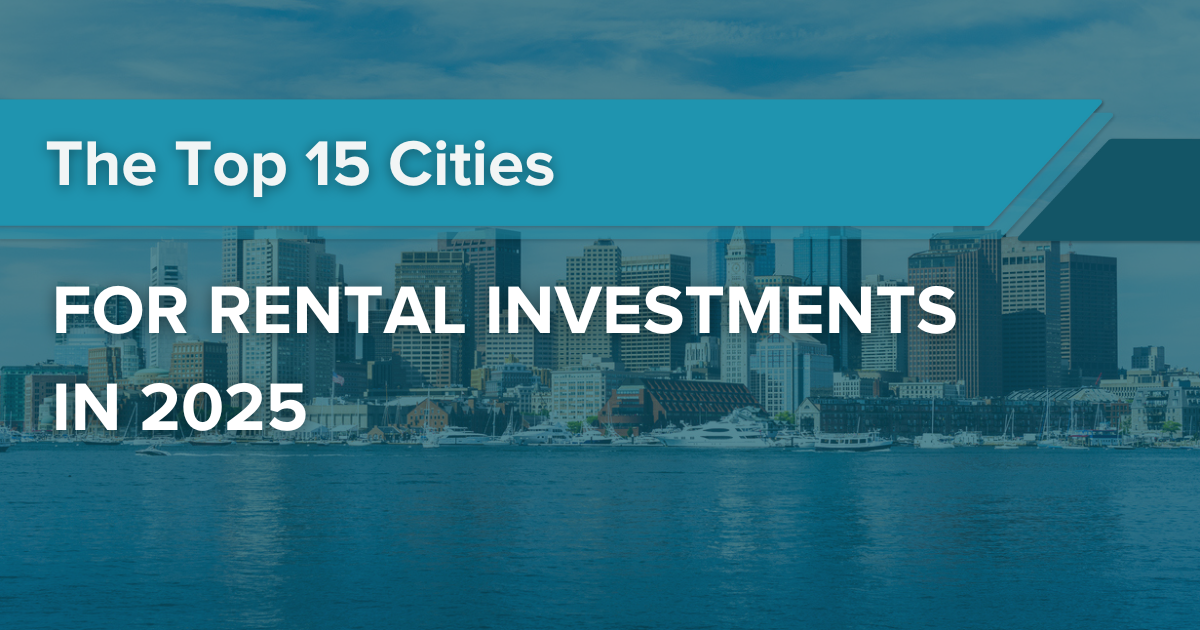Buying rental property is a great way to earn passive income and benefit from long-term appreciation. With a lending partner like ABL, you can unlock long-term rental loans that help you maximize your returns.
Take a look at the top 15 cities for rental investments in 2025 and connect with a local loan officer from each of them.
What to Look for in a Rental Market as an Investor
When comparing rental markets, there are many variables to consider. Here are six we used:
Median rental yield
Rental yield compares a property’s income as a percentage of its market value (annual rent / property value = rental yield). The higher the rental yield, the more profitable the property.
Population growth
Population growth measures how fast a city is growing. The more people move in each year, the greater the potential tenant pool and rental opportunities.
Home appreciation rate
The rate at which home values rise is called appreciation. It’s typically measured on an annual basis and can help you estimate a rental property’s future value.
Rent growth rate
As with home values, rents tend to increase over time, which makes rentals a good hedge against inflation. Rent growth is typically measured on an annual basis.
Percentage of renters
A city is largely made up of homeowners and renters. The greater the percentage of renters, the more rental investment opportunities there will be.
Vacancy rate
Vacancy rate measures how many of a city’s total rental units are empty on average. The lower the vacancy rate, the less money you can expect to lose from owning empty properties.
Now without further ado,
Here are the Top 15 Best Cities for Rental Property Investment in 2025:
1. Boston, MA
With a solid rental yield and low vacancy rates, Boston, Massachusetts, has a high demand for rental housing, making it a strong choice for investors seeking stability in a growing metro area.
| Median rental yield | 5.9% |
| Annual population growth | 16,153 |
| Annual home appreciation rate | 6.0% |
| Annual rent growth rate | 0.3% |
| Percentage of renters | 40.1% |
| Vacancy rate | 2.5% |
2. Columbus, OH
A booming population and competitive rental yield position Columbus, Ohio, as a standout city for maximizing returns in the Midwest.
| Median rental yield | 5.3% |
| Annual population growth | 18,205 |
| Annual home appreciation rate | 5.8% |
| Annual rent growth rate | 0.7% |
| Percentage of renters | 41.4% |
| Vacancy rate | 5.8% |
3. Knoxville, TN
Knoxville, Tennessee, combines steady home appreciation with impressive rent growth, making it an excellent market for long-term investors.
| Median rental yield | 5.6% |
| Annual population growth | 13,343 |
| Annual home appreciation rate | 6.6% |
| Annual rent growth rate | 1.3% |
| Percentage of renters | 35.7% |
| Vacancy rate | 4.2% |
4. Washington, D.C.
As the nation’s capital, Washington, D.C. boasts a large tenant pool and resilient home value appreciation, even in challenging market conditions.
| Median rental yield | 6.0% |
| Annual population growth | 39,084 |
| Annual home appreciation rate | 5.4% |
| Annual rent growth rate | -2.6% |
| Percentage of renters | 34.9% |
| Vacancy rate | 5.5% |
5. Dallas, TX
Dallas, Texas’s explosive population growth and strong rental yield offer exciting opportunities for high-demand investments in a thriving metro.
| Median rental yield | 6.13% |
| Annual population growth | 152,598 |
| Annual home appreciation rate | 1.2% |
| Annual rent growth rate | 0.5% |
| Percentage of renters | 38.3% |
| Vacancy rate | 8.4% |
6. Richmond, VA
Richmond, Virginia’s rising home values and significant rent growth underscore its potential as a profitable, up-and-coming rental market.
| Median rental yield | 4.95% |
| Annual population growth | 11,494 |
| Annual home appreciation rate | 5.6% |
| Annual rent growth rate | 5.9% |
| Percentage of renters | 35.1% |
| Vacancy rate | 5.2% |
7. Orlando, FL
With robust population growth, Orlando, Florida, remains an attractive destination for investors targeting a diverse and expanding rental market.
| Median rental yield | 5.0% |
| Annual population growth | 54,916 |
| Annual home appreciation rate | 4.5% |
| Annual rent growth rate | -2.7% |
| Percentage of renters | 38.1% |
| Vacancy rate | 7.0% |
8. Seattle, WA
Seattle, Washington, offers a balance of steady rent growth and low vacancy rates, making it a reliable choice for long-term rental profitability.
| Median rental yield | 4.38% |
| Annual population growth | 12,595 |
| Annual home appreciation rate | 4.2% |
| Annual rent growth rate | 1.1% |
| Percentage of renters | 37.3% |
| Vacancy rate | 4.0% |
9. Tulsa, OK
Tulsa, Oklahoma’s strong rental yield and high rent growth create favorable conditions for investors seeking solid cash flow opportunities.
| Median rental yield | 5.62% |
| Annual population growth | 10,709 |
| Annual home appreciation rate | 1.8% |
| Annual rent growth rate | 6.3% |
| Percentage of renters | 37.2% |
| Vacancy rate | 6.7% |
10. Fresno, CA
With a high percentage of renters and consistently growing rents, Fresno, California, presents strong opportunities for investors in the state’s rental scene.
| Median rental yield | 4.83% |
| Annual population growth | 4,332 |
| Annual home appreciation rate | 3.9% |
| Annual rent growth rate | 3.1% |
| Percentage of renters | 45.8% |
| Vacancy rate | 3.4% |
11. Charleston, SC
Charleston, South Carolina’s high rental yield and impressive population growth make it a standout market for investors looking for dynamic growth potential.
| Median rental yield | 6.78% |
| Annual population growth | 19,065 |
| Annual home appreciation rate | 5.7% |
| Annual rent growth rate | 1.3% |
| Percentage of renters | 30.4% |
| Vacancy rate | 12.0% |
12. Cincinnati, OH
Cincinnati, Ohio, pairs steady home value appreciation with a high rental yield, offering a balanced approach to rental property investments.
| Median rental yield | 6.09% |
| Annual population growth | 12,854 |
| Annual home appreciation rate | 5.8% |
| Annual rent growth rate | 2.1% |
| Percentage of renters | 30.4% |
| Vacancy rate | 7.2% |
13. Atlanta, GA
Atlanta, Georgia’s rapid population growth and competitive rental yield make it a promising market despite recent rent fluctuations.
| Median rental yield | 6.58% |
| Annual population growth | 68,585 |
| Annual home appreciation rate | 4.0% |
| Annual rent growth rate | -8.1% |
| Percentage of renters | 32.5% |
| Vacancy rate | 8.7% |
14. Indianapolis, IN
Indianapolis, Indiana, combines high rent growth and strong rental yields, positioning it as a top contender for investors seeking cash flow.
| Median rental yield | 5.7% |
| Annual population growth | 17,807 |
| Annual home appreciation rate | 4.6% |
| Annual rent growth rate | 6.9% |
| Percentage of renters | 29.8% |
| Vacancy rate | 8.8% |
15. Charlotte, NC
Charlotte, North Carolina’s strong population growth and rental market make it an appealing choice for investors seeking long-term opportunities in a thriving metro area.
| Median rental yield | 5.16% |
| Annual population growth | 50,458 |
| Annual home appreciation rate | 3.1% |
| Annual rent growth rate | -8.1% |
| Percentage of renters | 35.2% |
| Vacancy rate | 6.6% |
Partner with ABL to Buy Your Next Rental Property
Take your rental business to the next level by partnering with ABL.
Our long-term rental loans close in as few as 30 days so you can seize opportunities fast. See if you pre-qualify today with 100% confidentiality, no impact on your credit, and no obligation!
Methodology
To determine the best cities for rental property investment, we ranked the biggest U.S. metros by the following metrics:
- Median rental yield based on median 2023 sales prices of existing single-family homes (data by National Association of Realtors) and median November 2024 rents (data by Zumper)
- Annual population growth between July 1, 2022 and July 1, 2023 based on U.S. Census data
- Annual home value appreciation between Q3 2023 and Q3 2024 based on the Federal Housing Finance Agency’s Home Price Index (HPI)
- Annual rent growth between November 2023 and November 2024 (data by Zumper)
- Percentage of renters in 2023 based on U.S. Census data
- Vacancy rate in 2023 based on U.S. Census data
Each category was weighted equally to arrive at a composite score for 59 different U.S. metro areas (Las Vegas, NV, Omaha, NE, and metros for which there wasn’t data in any of the six categories were omitted from consideration).







0 Comments